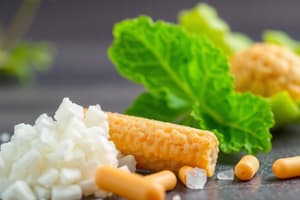Podcast
Questions and Answers
Which of the following is NOT a type of carbohydrate?
Which of the following is NOT a type of carbohydrate?
- Sugars
- Fiber
- Proteins (correct)
- Starches
Disaccharides are made of three monosaccharides.
Disaccharides are made of three monosaccharides.
False (B)
What is the primary energy source for the body?
What is the primary energy source for the body?
Glucose
Fiber is found in fruits, vegetables, and __________.
Fiber is found in fruits, vegetables, and __________.
Match the following types of carbohydrates with their descriptions:
Match the following types of carbohydrates with their descriptions:
What is the role of insulin in carbohydrate metabolism?
What is the role of insulin in carbohydrate metabolism?
The small intestine is where most carbohydrate digestion occurs.
The small intestine is where most carbohydrate digestion occurs.
Name one source of starch.
Name one source of starch.
After eating, blood glucose levels __________ due to the intake of carbohydrates.
After eating, blood glucose levels __________ due to the intake of carbohydrates.
What form is excess glucose stored in the body?
What form is excess glucose stored in the body?
Which type of fiber dissolves in water and helps lower cholesterol?
Which type of fiber dissolves in water and helps lower cholesterol?
Natural sugars found in fruits are generally harmful and should be avoided.
Natural sugars found in fruits are generally harmful and should be avoided.
What is the recommended daily fiber intake for optimal health?
What is the recommended daily fiber intake for optimal health?
High GI foods include __________ and rice cakes.
High GI foods include __________ and rice cakes.
Match the following carbohydrates with their effects:
Match the following carbohydrates with their effects:
Which of these foods are classified as low GI?
Which of these foods are classified as low GI?
Artificial sweeteners have no calories and do not affect blood sugar levels.
Artificial sweeteners have no calories and do not affect blood sugar levels.
What should you consume during long workouts lasting more than 90 minutes?
What should you consume during long workouts lasting more than 90 minutes?
What type of carbohydrates should people with diabetes prioritize?
What type of carbohydrates should people with diabetes prioritize?
Counting carbs is essential to manage blood sugar levels in people with diabetes.
Counting carbs is essential to manage blood sugar levels in people with diabetes.
The brain uses about __________ of your body's energy.
The brain uses about __________ of your body's energy.
Which of the following is a con of low-carb diets?
Which of the following is a con of low-carb diets?
What is the equivalent of 1 gram of carbohydrates in calories?
What is the equivalent of 1 gram of carbohydrates in calories?
Chose __________ carbs over simple sugars for better blood sugar management.
Chose __________ carbs over simple sugars for better blood sugar management.
Match the following food items with their healthier carb alternatives:
Match the following food items with their healthier carb alternatives:
Which of the following is NOT a recommended healthy carb choice?
Which of the following is NOT a recommended healthy carb choice?
Fiber content is not important when reading food labels for carbs.
Fiber content is not important when reading food labels for carbs.
Name one plant-based carb alternative mentioned.
Name one plant-based carb alternative mentioned.
Aim for __________ to __________ grams of fiber daily.
Aim for __________ to __________ grams of fiber daily.
What is a key takeaway for managing carbs in a healthy diet?
What is a key takeaway for managing carbs in a healthy diet?
Flashcards
Carbohydrates
Carbohydrates
Essential nutrients made of carbon, hydrogen, and oxygen, providing energy like fuel for the body.
Monosaccharides
Monosaccharides
Simplest carbohydrates, like Lego blocks for larger structures.
Glucose
Glucose
Body's preferred energy source, a type of simple sugar/monosaccharide.
Disaccharides
Disaccharides
Signup and view all the flashcards
Sucrose
Sucrose
Signup and view all the flashcards
Polysaccharides
Polysaccharides
Signup and view all the flashcards
Starch
Starch
Signup and view all the flashcards
Fiber
Fiber
Signup and view all the flashcards
Carb Digestion
Carb Digestion
Signup and view all the flashcards
Blood Glucose
Blood Glucose
Signup and view all the flashcards
Glycemic Index (GI)
Glycemic Index (GI)
Signup and view all the flashcards
High GI foods
High GI foods
Signup and view all the flashcards
Medium GI foods
Medium GI foods
Signup and view all the flashcards
Low GI foods
Low GI foods
Signup and view all the flashcards
Fiber
Fiber
Signup and view all the flashcards
Soluble fiber
Soluble fiber
Signup and view all the flashcards
Insoluble fiber
Insoluble fiber
Signup and view all the flashcards
Added sugars
Added sugars
Signup and view all the flashcards
Artificial sweeteners
Artificial sweeteners
Signup and view all the flashcards
Carbs and Exercise
Carbs and Exercise
Signup and view all the flashcards
Low-Carb Diets
Low-Carb Diets
Signup and view all the flashcards
Carbs and Brain Function
Carbs and Brain Function
Signup and view all the flashcards
Carbs and Heart Health
Carbs and Heart Health
Signup and view all the flashcards
Carb Management for Diabetes
Carb Management for Diabetes
Signup and view all the flashcards
Complex Carbs vs. Simple Sugars
Complex Carbs vs. Simple Sugars
Signup and view all the flashcards
Food Label Carbs
Food Label Carbs
Signup and view all the flashcards
Carb to Calorie Ratio
Carb to Calorie Ratio
Signup and view all the flashcards
Healthy Carb Swaps
Healthy Carb Swaps
Signup and view all the flashcards
Future Carb Trends
Future Carb Trends
Signup and view all the flashcards
Fiber Intake
Fiber Intake
Signup and view all the flashcards
Balanced Diet
Balanced Diet
Signup and view all the flashcards
Carb vs. Health
Carb vs. Health
Signup and view all the flashcards
Study Notes
Carbohydrates: Chapter 4
- Carbohydrates are essential nutrients made of carbon, hydrogen, and oxygen.
- They are the body's primary energy source.
- There are three main types: sugars, starches, and fiber.
- Sugars are simple carbohydrates.
- Starches and fiber are complex carbohydrates.
- Think of carbohydrates as the gas that keeps your body running smoothly.
Monosaccharides: The Building Blocks
- Monosaccharides are the simplest carbohydrates, like Lego pieces.
- Glucose is the body's preferred energy source.
- Fructose is found in fruits and honey.
- Galactose is part of milk sugar.
- These are the foundation of all carbohydrates you eat.
Disaccharides: Dynamic Duos
- Disaccharides are made of two monosaccharides.
- Sucrose (table sugar) is made of glucose + fructose.
- Lactose (milk sugar) is made of glucose + galactose.
- Maltose (malt sugar) is made of glucose + glucose.
- These are found in many sweet treats.
Polysaccharides: The Complex Carbs
- Polysaccharides are long chains of simple sugars, like a long necklace.
- Starch is found in potatoes, rice, and bread.
- Fiber is found in fruits, vegetables, and whole grains.
- Glycogen is how the body stores carbohydrates for later use.
- These provide lasting energy and keep you feeling full longer.
Carb Digestion: Breaking It Down
- The body breaks down carbohydrates into glucose for energy.
- Saliva starts breaking down starches in the mouth.
- Not much carbohydrate digestion happens in the stomach.
- Most carbs are broken down and absorbed in the small intestine.
- Fiber is fermented by gut bacteria in the large intestine.
- Carb digestion is like a carb assembly line in reverse.
Blood Glucose: The Balancing Act
- The body works hard to keep blood glucose levels stable.
- After eating, blood glucose rises.
- The pancreas releases insulin to help cells absorb glucose.
- Excess glucose is stored as glycogen or fat.
- Between meals, glycogen is broken down to maintain blood glucose.
- Blood glucose regulation is a constant tug-of-war to keep energy levels steady.
Glycemic Index: Not All Carbs Are Created Equal
- The Glycemic Index (GI) measures how quickly foods raise blood sugar.
- High GI foods (70+) include white bread and rice cakes.
- Medium GI foods (56-69) include whole wheat bread and brown rice.
- Low GI foods (55 or less) include most fruits, vegetables, and legumes.
- Choosing low GI foods results in steadier energy and better health.
Fiber: The Unsung Hero
- Fiber is a type of carbohydrate the body can't digest.
- Soluble fiber dissolves in water, helping to lower cholesterol.
- Insoluble fiber promotes regular bowel movements.
- Aim for 25-30 grams of fiber per day for optimal health.
Sugar: The Sweet Villain?
- Added sugars can be harmful in excess.
- Added sugars are found in sodas, candies, and baked goods.
- Added sugars may contribute to weight gain and tooth decay.
- Limit added sugars to less than 10% of daily calories.
- Natural sugars in fruits and milk are generally okay.
Artificial Sweeteners
- Artificial sweeteners are sugar substitutes with pros and cons.
- Pros: Few or no calories; don't raise blood sugar.
- Cons: May increase cravings for sweet foods; possible negative effects on gut bacteria.
- Use in moderation.
Carbs and Exercise
- Carbohydrates are crucial for exercise performance.
- Consume easily digestible carbs before exercise for energy.
- Consume carbs during long workouts to maintain energy.
- Replenish glycogen stores with carbs and protein after exercise.
- Fuel your body properly for optimal fitness goals.
Low-Carb Diets: Fad or Fab?
- Low-carb diets are popular but controversial.
- Potential pros: weight loss and improved blood sugar control.
- Potential cons: difficulty sustaining the diet and potential nutrient deficiencies.
- Consult a doctor before starting any new diet.
Carbs and Brain Function
- The brain uses approximately 20% of the body's energy.
- Glucose is the primary fuel for brain cells.
- Low blood sugar can lead to confusion and irritability.
- Feed your brain with complex carbs for steady energy.
Carbs and Heart Health
- The right carbs can benefit heart health.
- Whole grains may reduce heart disease risk.
- Fiber can help reduce cholesterol levels.
- Too many refined carbs can increase heart disease risk.
- Choose whole grains and high-fiber foods for a healthy heart.
Carbs and Diabetes
- Carbohydrate management is key for people with diabetes.
- Carbohydrates have the biggest impact on blood sugar levels.
- Counting carbs helps control blood sugar levels.
- Choose complex carbohydrates over simple sugars.
- Work with a dietitian to create a personalized meal plan.
Reading Food Labels
- Become a food label detective.
- Look for "Total Carbohydrate" on the Nutrition Facts label.
- Note the fiber and added sugar content on labels.
- Knowledge is power when making healthy choices.
Healthy Carb Swaps
- Make swaps to improve carbohydrate choices.
- Swap white bread for whole grain bread.
- Swap sugary cereal for oatmeal with fruit.
- Swap soda for sparkling water.
- Swap potato chips for air-popped popcorn.
Future Trends in Carbohydrates
- Plant-based alternatives (e.g., cauliflower rice, zucchini noodles) are evolving.
- Research on resistant starch and personalized nutrition is occurring.
- New sugar alternatives are being developed.
Key Takeaways
- Choose complex carbs over simple sugars.
- Aim for 25-30 grams of fiber daily.
- Balance your plate with proteins, healthy fats, and carbohydrates.
- Listen to your body's hunger and fullness cues.
- Enjoy carbohydrates as part of a healthy diet.
Studying That Suits You
Use AI to generate personalized quizzes and flashcards to suit your learning preferences.




